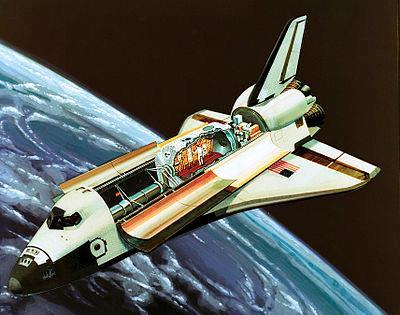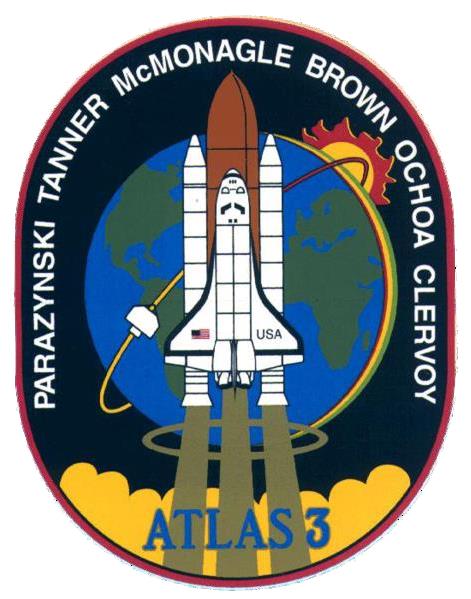Jean-Francois Clervoy,
Astronauts:
Command Pilot:
Donald R. McMonagle
(Third Space Flight)
Pilot:
Curtis L. Brown Jr.
(Second Space Flight) Mission Specialist 1:
Ellen Ochoa
(Second Space Flight) Payload Commander Mission Specialist 2:
Joseph R. Tanner
(First Space Flight)
Mission Specialist 3:
CNES
(First Space Flight) Mission Specialist 4:
Scott E. Parazynski
(First Space Flight)
Spacelab was a reusable laboratory used on certain spaceflights flown by the Space Shuttle. The laboratory comprised multiple components, including a pressurized module, an unpressurized carrier and other related hardware housed in the Shuttle's cargo bay. The components were arranged in various configurations to meet the needs of each spaceflight.
Spacelab components flew on 22 Shuttle missions between November 1983 and April 1998. Spacelab allowed scientists to perform experiments in microgravity in Earth orbit.
STS-66 further advanced comprehensive effort to collect data about sun's energy output, chemical makeup of the Earth's middle atmosphere, and how these factors affect global ozone levels. Seven instruments on the Atmospheric Laboratory for Applications and Science-3 (ATLAS-3) also flew on first two ATLAS flights. No other collection of space-based instruments provides same extensive range of atmospheric measurements. Also considered a primary payload was the Cryogenic Infrared Spectrometers and Telescopes for the Atmosphere-Shuttle Pallet Satellite (CRISTA-SPAS), continuing joint NASA-German Space Agency (DARA) series of scientific missions. ATLAS-3 and CRISTA-SPAS considered as joint mission with single set of science objectives. During mission, crew divided into two teams for around-the-clock research.
ATLAS-3 instruments, mounted on a Spacelab pallet in cargo bay, included Atmospheric Trace Molecule Spectroscopy (ATMOS), which collected more data on trace gases in the atmosphere than on all three of its previous flights combined; Shuttle Solar Backscatter Ultraviolet Spectrometer (SSBUV), which took ozone measurements to calibrate ozone monitor on aging NOAA-9 satellite as well as cooperative measurements with other ATLAS-3 instruments; Active Cavity Radiometer Irradiance Monitor (ACRIM), which took extremely precise measurements of the sun's total radiation for 30 orbits as calibration reference for sister instrument on Upper Atmosphere Research Satellite (UARS) launched in 1991; Measurement of the Solar Constant (SOLCON), provided by Belgium, which also measured solar radiation but as reference point to track changes over years; Solar Spectrum Measurement (SOLSPEC), French instrument, measured sun's radiation as function of wavelength; and Solar Ultraviolet Spectral Irradiance Monitor (SUSIM), which collected its highest precision solar ultraviolet radiation measurements in its 15-year lifetime. Millimeter Wave Atmospheric Sounder (MAS), collected nine hours of observations, measuring distribution of water vapor, chlorine monoxide and ozone at altitudes between 12 and 60 miles (20-100 kilometers), before computer malfunction halted instrument operations.
CRISTA-SPAS released from orbiter's Remote Manipulator System arm on second day of mission. Flying at distance of about 25-44 miles (40-70 kilometers) behind the shuttle, payload collected data for more than eight days before being retrieved and returned to cargo bay. CRISTA instrument gathered first global information about medium- and small- scale disturbances in trace gases in middle atmosphere, which could lead to better models of the atmosphere and Earth's energy balance. Second CRISTA-SPAS instrument, the Middle Atmosphere High Resolution Spectrograph Investigation (MAHRSI) measured amounts of ozone-destroying hydroxyl and nitric oxide in the middle atmosphere and lower thermosphere from 24-72 miles (40-120 kilometers). MAHRSI yielded first complete global maps of hydroxyl in atmosphere.
For retrieval of CRISTA-SPAS, different approach method to spacecraft was successfully tested as prelude to upcoming U.S. Shuttle/Russian Space Station Mir docking flights. Called R-Bar approach, it is expected to save propellant while reducing risk of contamination to Mir systems from orbiter thruster jet firings.
Spacelab Space Missions
Study Research
Space Cosmology
Science Research
*
About
Science Research
Science Theories
Site Map
BookShelf
Desk
Copyright © by Nigel G Wilcox · All Rights reserved · E-Mail: ngwilcox100@gmail.com
Designed by Nigel G Wilcox
Powered By AM3L1A
Pages within this section: Spacelab 01-32
Spacelab C21-30
Spacelab 022 - STS-66
Mission Name: ATLAS-3
(Second Space Flight
Sub-Menu
21
M
menu
22
23
24
25
26
27
8
29
30
28
>>>
D
SM









